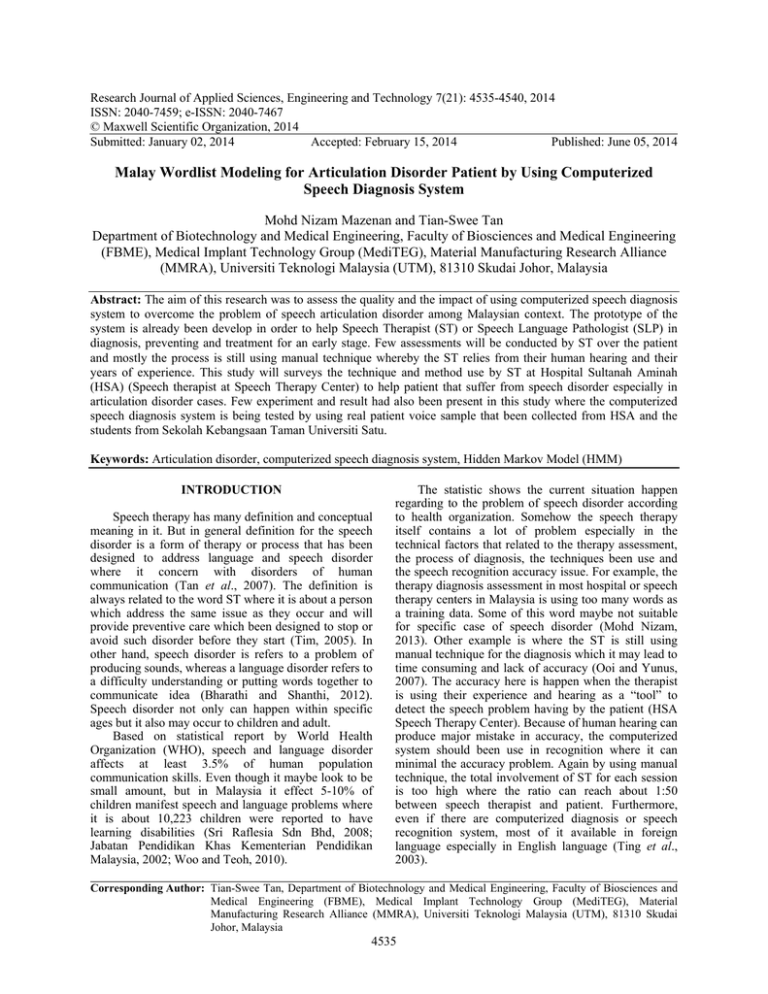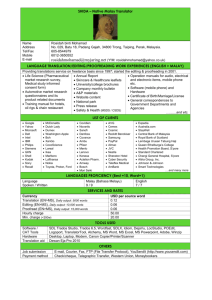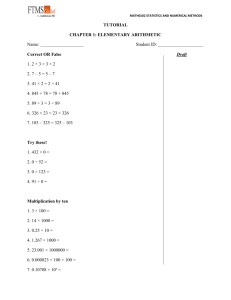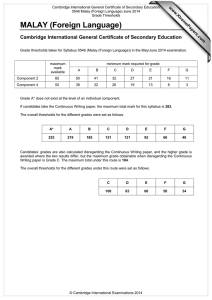Research Journal of Applied Sciences, Engineering and Technology 7(21): 4535-4540,... ISSN: 2040-7459; e-ISSN: 2040-7467
advertisement

Research Journal of Applied Sciences, Engineering and Technology 7(21): 4535-4540, 2014
ISSN: 2040-7459; e-ISSN: 2040-7467
© Maxwell Scientific Organization, 2014
Submitted: January 02, 2014
Accepted: February 15, 2014
Published: June 05, 2014
Malay Wordlist Modeling for Articulation Disorder Patient by Using Computerized
Speech Diagnosis System
Mohd Nizam Mazenan and Tian-Swee Tan
Department of Biotechnology and Medical Engineering, Faculty of Biosciences and Medical Engineering
(FBME), Medical Implant Technology Group (MediTEG), Material Manufacturing Research Alliance
(MMRA), Universiti Teknologi Malaysia (UTM), 81310 Skudai Johor, Malaysia
Abstract: The aim of this research was to assess the quality and the impact of using computerized speech diagnosis
system to overcome the problem of speech articulation disorder among Malaysian context. The prototype of the
system is already been develop in order to help Speech Therapist (ST) or Speech Language Pathologist (SLP) in
diagnosis, preventing and treatment for an early stage. Few assessments will be conducted by ST over the patient
and mostly the process is still using manual technique whereby the ST relies from their human hearing and their
years of experience. This study will surveys the technique and method use by ST at Hospital Sultanah Aminah
(HSA) (Speech therapist at Speech Therapy Center) to help patient that suffer from speech disorder especially in
articulation disorder cases. Few experiment and result had also been present in this study where the computerized
speech diagnosis system is being tested by using real patient voice sample that been collected from HSA and the
students from Sekolah Kebangsaan Taman Universiti Satu.
Keywords: Articulation disorder, computerized speech diagnosis system, Hidden Markov Model (HMM)
INTRODUCTION
Speech therapy has many definition and conceptual
meaning in it. But in general definition for the speech
disorder is a form of therapy or process that has been
designed to address language and speech disorder
where it concern with disorders of human
communication (Tan et al., 2007). The definition is
always related to the word ST where it is about a person
which address the same issue as they occur and will
provide preventive care which been designed to stop or
avoid such disorder before they start (Tim, 2005). In
other hand, speech disorder is refers to a problem of
producing sounds, whereas a language disorder refers to
a difficulty understanding or putting words together to
communicate idea (Bharathi and Shanthi, 2012).
Speech disorder not only can happen within specific
ages but it also may occur to children and adult.
Based on statistical report by World Health
Organization (WHO), speech and language disorder
affects at least 3.5% of human population
communication skills. Even though it maybe look to be
small amount, but in Malaysia it effect 5-10% of
children manifest speech and language problems where
it is about 10,223 children were reported to have
learning disabilities (Sri Raflesia Sdn Bhd, 2008;
Jabatan Pendidikan Khas Kementerian Pendidikan
Malaysia, 2002; Woo and Teoh, 2010).
The statistic shows the current situation happen
regarding to the problem of speech disorder according
to health organization. Somehow the speech therapy
itself contains a lot of problem especially in the
technical factors that related to the therapy assessment,
the process of diagnosis, the techniques been use and
the speech recognition accuracy issue. For example, the
therapy diagnosis assessment in most hospital or speech
therapy centers in Malaysia is using too many words as
a training data. Some of this word maybe not suitable
for specific case of speech disorder (Mohd Nizam,
2013). Other example is where the ST is still using
manual technique for the diagnosis which it may lead to
time consuming and lack of accuracy (Ooi and Yunus,
2007). The accuracy here is happen when the therapist
is using their experience and hearing as a “tool” to
detect the speech problem having by the patient (HSA
Speech Therapy Center). Because of human hearing can
produce major mistake in accuracy, the computerized
system should been use in recognition where it can
minimal the accuracy problem. Again by using manual
technique, the total involvement of ST for each session
is too high where the ratio can reach about 1:50
between speech therapist and patient. Furthermore,
even if there are computerized diagnosis or speech
recognition system, most of it available in foreign
language especially in English language (Ting et al.,
2003).
Corresponding Author: Tian-Swee Tan, Department of Biotechnology and Medical Engineering, Faculty of Biosciences and
Medical Engineering (FBME), Medical Implant Technology Group (MediTEG), Material
Manufacturing Research Alliance (MMRA), Universiti Teknologi Malaysia (UTM), 81310 Skudai
Johor, Malaysia
4535
Res. J. Appl. Sci. Eng. Technol., 7(21): 4535-4540, 2014
Therefore for an early diagnosis setup, this study
will propose computerized technique that use speech
recognition that been model by basic Malay language
corpus design specifically for articulation disorder.
Starting from training the database until recognition of
unknown sample data will been done by using HMM
technique that also covers the result of accuracy in
analysis and diagnosis process.
MATERIALS AND METHODS
Experimental setup: An experiment had been
conducted where the goal is to find the accuracy for
recognition rate by having a control set of specific
target words database which focus more on Malay
speech therapy target word. Most of this words can help
ST to understand the patients articulatory disability
before ST can design an effective therapy strategies that
consist set of exercise or training to cure the patient
who having speech disorder. But for an early stage, this
selected consonant will work on early diagnosis phase
for the whole speech recognition system. Based on
previous research at HSA, Malay word for therapy are
about 108 words which cover most of the Malay
articulation function. Table 1 show the total of the
simplify target words for Malay speech therapy word
design.
In this table, the target word will tackle Malay
speech articulation function that concern in solving the
problem in speech therapy for speech disorder. There
are target words that will cover from Malay consonant,
Malay vowel, Malay alveolar and Malay plosives.
Malay consonant consists of alphabet (B, D, G, K, L, N,
P, R, S, T and Z), Malay vowel consists of alphabet (A,
E, I, O, U), Malay alveolar consists of alphabet (D, L,
N, R, S, T, Z) and lastly for Malay plosives will cover
alphabet (B, D, G, K, P, T).
By using the HMM as the statistical analysis tool in
recognition process and Mel-cepstral Frequency
Coefficient extraction (MFCC) as feature extraction
technique, this experiment is started by capturing the
voice sample of the training and target patient. For the
sample data collection in this experiment, there are 80
children are involved in Malay target word database for
normal speech children. Therefore, each sample needs
to speak the word for 6 times to keep the consistency of
the wave signal where altogether is about 47520 sample
voices has been collected. The training data has
Table 1: Target words for Malay speech therapy word design
Consonant Word target
A
Abjad, angsa, arnab, ayam
B
Baju, baldi, bantal, belon, biskut, botol, buku
D
Dadu, daun, delima, dodol, dua, duit, duku, durian
E
Empat, enam, epal
G
Gajah, garfu, gelas, gigi
I
Ikan, itik
K
Kacang, kad, kambing, kancil, kasut, katak, katil, kek, kelapa, keli, kera, kerang, kijang, kipas, komputer, kopi, kotak,
kucing, kunci
L
Lampu, langsat, lapan, lembu, lima, limau, lobak, lutut
N
Nanas, nangka, nasi, nyamuk
O
oren
P
Payung, pensel, pinggan, pisang, pisau, puding
R
Radio, raga, rambut, rebung, ringgit, roti, rumah
S
Sabun, satu, seluar, sembilan, semut, sepuluh, siput, sotong, sudu, syampu
T
Tangan, televisyen, telinga, tiga, tikus, tilam, timun, tisu, topi, tuala, tujuh
U
Ubat, udang, ular
Z
Zip, zoo
Total
Fig. 1: Sample of normal voice sample in a form of spectrogram and waveform
4536
Total
4
7
8
3
4
2
19
8
4
1
6
7
10
11
3
2
99
Res. J. Appl. Sci. Eng. Technol., 7(21): 4535-4540, 2014
approximately 0.0-1500 msec data length. The data
sampling rate of the recording was been collected by
using GoldWave software at 16 kHz and 16-bit
resolution format by using standard vocal microphone.
The recording was been done in quiet room
environment that specifically for speech therapy to
avoid disturbance unknown noise. There are about 15
speech disorder children and 10 normal speech children
will be involved in testing the accuracy of the unknown
recognition phase. The training data for speech signal
sample is illustrated in Fig. 1. Before the training
sample been uniformly segmentize, extracting the
information by using Feature Extraction (FE) and tying
the model, we need to design the dictionary for each of
the word that need to be test. Assuming we are using
standard Malay phoneme based pronunciation
dictionary for our target words, where it has been used
to describe the phones HMM acoustic model for the
mapping process to form a word for both training and
decoding purpose. The list of Malay phoneme will be
generated by the -n argument and stored in file
monophones1.rtf by using standard HMM command.
After the sample data been collected, next step as
follows.
Speech signal processing: Speech processing converts
the speech waveform into parametric representation.
The conversion of the waveform been done by FE
where the speech features are used as an inputs to the
speech recognition. The FE will construct the
combination of variables to get around these problems
while still describing the data with sufficient accuracy.
In this experiment, we will fully utilize the use of 12
Mel-Frequency Cepstral Coefficient (MFCC) (Davis
and Mermelsten, 1980). Axelsson and Bjo¨rhall (2003)
explained that MFCC has characteristics of the human
auditory system and commonly used in the Automatic
Speech Recognition systems (ASR). The front end
parameterized an input speech signal into a sequence of
MFCC vectors. The process of this front end is shown
in Fig. 2.
Pre-emphasize: In the pre-emphasize stage, the speech
sample filtering is applied in Eq. (1) to spectrally flatten
the signal frames as the high concentration of energy
frequencies will be using to evaluate and be used to
reduce the effects of the glottal pulses and radiation
impedance whereby it can focusing more on the
spectral properties of the vocal tract. The value of
constant a is generally around 0.9 and 1.0 (Jadhav
et al., 2013). In our research we used a = 0.97. The preemphasize speech signal, ŝ (n) will be sent through a
high pass filter according to the Eq. (2):
H (z) = 1-az-1
(1)
sˆ (n) = s (n) - as (n - 1)
(2)
Fig. 2: Process of MFCC front end
(a)
(b)
Fig. 3: Effect of multiplying a hamming window by Jang
(2011)
Windowing: After the pre-processing of the speech
sample, there are spectral leakages during the selection
of frame locations and frame blocking process of nonstationary signals. This is because of the Finite Impulse
Response (FIR) that will results ripples in the stop band
and pass band of the filter frequency response that is
due to Gibb’s phenomena. The windowing function will
multiplied to the filter impulse response to minimize
this effect on each spectral frame. Hamming window
will reduce the signal discontinuities where the signal is
windowed and multiplying in such a way that the
frames overlap (Fig. 3) which w (n) been denoted as
Eq. (3):
2π n
w(n) = 0.54 - 0.46 cos
M -1
=0
0 ≤ n ≤ M -1
(3)
otherwise
The overlapping that happen in hamming window
will avoid discontinuities on both side lobes of each
window.
4537
Res. J. Appl. Sci. Eng. Technol., 7(21): 4535-4540, 2014
Mel-frequency cepstrum coefficients computation:
The MFCC had been choose as a FE for this experiment
prior to the characteristic of this FE which based on
human auditory system that focusly on non-uniformly
spectral envelop and also widely use in Automatic
Speech Recognition (ASR) systems (Axelsson and
Bjo¨rhall, 2003; Grigore et al., 2011). MFCC will be
able to extract important phonetically information of
the signals by focusing on lower range of the Mel
frequencies. The log mel-scale filter bank is expressed
in a form of linear frequency below 1 kHz and a
logarithm spacing above 1 kHz that mimic human ear’s
perceived frequency (Davis and Mermeslsten, 1980).
Mel-Scale been described in Eq. (4):
mel (f) = 2595 log (1 + f/700)
(4)
where,
f
: The real frequency
mel (f) : The perceived frequency
Next, the input training speech sample is
transformed by using short-time Fourier Transform
method from the time domain to frequency domain that
been shown in Eq. (5). W (n) in Eq. (5) is the Hamming
window function, that derived the speech signal which
it can be treated as stationary and not influenced by
other signals within short period of time:
N -1
Y(m ) = ∑ x̂ i (n ) • e
- 2jnπ
m
N
(5)
n =0
The energy spectrum need to be found as denoted
exactly in Eq. (6):
X (m ) = Y (m )
2
For the short time energy coefficient is where it
incorporated to cepstral coefficients because it contains
valuable discriminative information among different
phonemic characteristics. Vowels exhibit much larger
energy values than fricatives, plosives and silence.
Normalized energy is used to normalize speaker
loudness variation. Energy can be computed from
waveform as:
(
)
N −1
2
E = log ∑ xˆ (n )
n =0
(9)
In Eq. (9), E is energy for frame l, which has N
discrete time sample in it. As a result, xˆ1 (n ) has been
windowed.
A feature vector is usually consists of 12 MFCC
and energy coefficient can be length 39 by taking
account the first order derivative of cepstral coefficient
(delta coefficients) and second order derivative of
cepstral coefficient (Delta-Delta coefficients) and
acceleration of speech and energy coefficient. Based on
previous research by Stemmer et al. (2001), this first
and second order derivative and normalized energy are
added to mel frequency cepstral coefficients that
consists of the differences of features between
predecessor and successor frames whereby it will
capture the dynamic changes of the signals. Those
experiments will add these delta coefficients to improve
recognition accuracy performance as follows:
•
(6)
The energy in each of mel window has to be
calculate in mathematical expression below:
First-order derivative of MFCC:
∆C t [n] = C t+1 [n] - C t-1 [n], 0≤n≤L
•
(10)
Second-order derivative of MFCC:
∆∆C t [n] = ∆ C t+1 [n] - ∆C t-1 [n], 0≤n≤L (11)
K
−1
2
S [k ] = ∑ Wk ( j )X ( j )
(7)
•
j =0
where, 1≤k≤M and M is the number of mel-window in
mel scale, which can generally range from 20 to 24. W k
(j) is the triangular weighted function associated with
kth mel window in mel scale.
After logarithm and cosine transforms, mel
frequency cepstral coefficients can be derived as
follow:
M
π
k −1
M
C[n] = ∑ Log ( S [k ]) cos[n(k − 0.5
L
: The desire order of the MFCC
c [0] : The zero order of MFCC
First and second
coefficient:
order
differenced
∆E t [n] = E t+1 [n] - E t-1 [n]
∆∆E t [n] = ∆E t+1 [n] - ∆ E t-1 [n]
where,
c [n] : The nth cepstral vector component for 0≤n≤L
(12)
A typical feature vector, yt is composed by those
MFCC acoustic vector and its first and second order
differences which can be characterized by:
y t = {E t , C t , ∆E t , ∆C t , ∆∆E t , ∆∆C t }
]
energy
(8)
(13)
RESULTS AND DISCUSSION
The speech signal in this experiment will be
process to evaluate the matching point between target
words with unknown speech signal that suppose to be
4538
Res. J. Appl. Sci. Eng. Technol., 7(21): 4535-4540, 2014
Table 2: Malay word recognition evaluation
Total
Word
sample
Correct
Abjad “alphabet”
200
179
Empat “four”
180
170
Itik “duck”
190
177
Oren “orange”
200
183
Ular “snake”
200
184
Error
21
10
13
17
16
Total sample
Correct
Error
250
200
150
100
50
0
Abjad
Empat
Itik
Oren
Ular
Fig. 4: Recognition evaluation of five Malay words
Accuracy
rate (%)
89.50
94.44
93.16
91.50
92.00
from the word “Arnab”. The total recognition
evaluation was in an excellent result.
CONCLUSION
In this study, a HMM has been use as the statistical
analysis tool in recognition process and MFCC as
feature extraction technique for front end parameterized
of input speech signal. Both technique are among the
best technique for ASR and still been using until today.
During the recognition evaluation test, the recognition
result from this experiment shows that the
approximation of the matching signal from training
model and unknown utterance is very well. Even the
lowest present is still in 80% above range which we can
consider that the recognition of an early phase of the
speech recognition system is very promising. Therefore,
more specific experiment needs to be conduct by
improving the language model and the utilization of the
recognition and segmentation technique.
correspond with the training model. The detection of
ACKNOWLEDGMENT
words accuracy rely on start and end points where the
subsequent processing of the data need to be kept to a
The authors gratefully acknowledge the research
minimum (Jadhav et al., 2013). The detection of this
grant
provided by Research Management Centre
start and end point is based on analyzing its energy
(RMC),
sponsored by Ministry of Higher Education
profile. When the energy of voice signal rise at the
(MOHE),
Malaysia. Vot: Q.J130000.2545.04H41 and
setup threshold value, it will marks the presence of
GUP
Universiti
Teknologi Malaysia, Johor Bahru,
voice input and vice versa.
Malaysia.
The experiment consists of training speech sample
taken from 80 children age from 8 to 13 years old, male
REFERENCES
and female. Each of samples will require speaking the
word for 6 times where altogether is about 47520
Axelsson, A. and E. Bjo¨rhall, 2003. Real time speech
sample voices has been collected. For the earlier output,
driven face animation. M.S. Thesis, The Image
only few results will be shown by taking only 5 sample
Coding Group, Department of Electrical
results of recognition evaluation that shown in Table 2.
As been stated above, there are about 15 speech
Engineering, Linko¨ping University, Linko¨ping.
disorder children and 10 normal speech children will be
Bharathi, C.R. and Dr. V. Shanthi, 2012. Disorder
involved in testing the accuracy of the unknown
speech clustering for clinical data using fuzzy Crecognition phase (Fig. 4).
means clustering and comparison with SVM
Based on the result, it shows that the word
classification. Indian J. Comut. Sci. Eng., 3:
“Empat” (“four”) achieve higher accuracy of
713-719.
recognition by the rate of 94.44% compare to the other
Davis, S. and P. Mermelsten, 1980. Comparison of
words. For the lowest recognition evaluation accuracy
parametric representation for monosyllabic word
goes to word “Abjad” (”alphabet”) where it capture
recognition in continuous spoken sentence. IEEE
only about 89.5%. After we see and analyze the result,
T. Acoust. Speech, 28: 357-366.
an early hypothesis can be made by assuming that, the
Grigore, O., C. Grigore and V. Velican, 2011.
word “Empat” can get the best accuracy in recognition
Impaiered speech evaluation using mel-cepstrum
is because there are no similar language model that
analysis. Int. J. Circ. Syst. Signal. Process., 5:
close to that word among the entire training model.
70-77.
Therefore the probability distribution of this sample
Jabatan Pendidikan Khas Kementerian Pendidikan
word utterance may be far and not close to each other.
Malaysia, 2002. Maklumat Pendidikan Khas Kuala
The hypothesis for the lowest recognition accuracy
Lumpur.
Kementerian Pendidikan Malaysia.
which is from the word “Abjad”, can be assume as the
Jadhav,
S.,
S.
Kava, S. Khandare, S. Marawar and
target word is close to other training word that may
S. Upadhya, 2013. Voice activated calculator. Int.
sound the same. The syllable of “Ab” and “jad” is near
J. Emerg. Technol. Adv. Eng., 3: 504-507.
to the pronunciation of word “kad” and syllable “nab”
4539
Res. J. Appl. Sci. Eng. Technol., 7(21): 4535-4540, 2014
Jang, J.S.R., 2011. Audio Signal Processing and
Recognition. In: Roger Jang’s Homepage.
Retrieved from: http://www.cs.nthu.edu.tw/~jang
(Accessed on: April 5, 2011).
Ooi, C.A. and J. Yunus, 2007. Computer-based system
to assess efficacy of stuttering therapy techniques.
Proceeding of the International Conference on
Biomedical Engineering, 15: 374-377.
Sri Raflesia Sdn Bhd, 2008. Learning Support and
Intervention Services. Web. Southampton.
Retrieved from: www.srirafelsia.com (Accessed
on: April 8, 2013).
Stemmer, G., C. Hacker, E. Noth and H. Niemann,
2001. Multiple time resolutions for derivatives of
Mel-frequency cepstral coefficients. Proceeding of
the IEEE Workshop on Automatic Speech
Recognition and Understanding (ASRU '01), pp:
37-40.
Tan, T.S., H. Liboh, A.K. Ariff, C.M. Ting and
S.H. Salleh, 2007. Application of Malay speech
technology in Malay speech therapy assistance
tools. Proceeding of the International Conference
on Intelligent and Advanced Systems, pp: 330-334.
Tim, P., 2005. Research Methods in Communication
Disorders. Whurr Publishers, Ltd., London.
Ting, H.N., J. Yunus, S. Vandort and L.C. Wong, 2003.
Computer-based Malay articulation training for
Malay plosives at Isolated, Syllable and Word
Level. Proceeding of the International Conference
on Infornation, Communication and Signal
Process, 3: 1423-1426.
Woo, P.J. and H.J. Teoh, 2010. An investigation of
cognitive and behavioural problems in children
with attention deficit hyperactive disorder and
speech delay. Malays. J. Psychiatr., 16: 50-58.
4540






